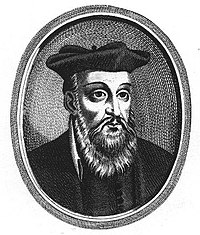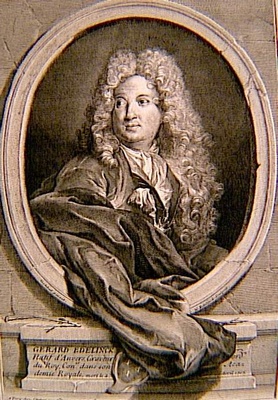
Gérard Edelinck was a copper-plate engraver and print publisher of Flemish origin, who worked in Paris from 1666 and became a naturalized French citizen in 1675.
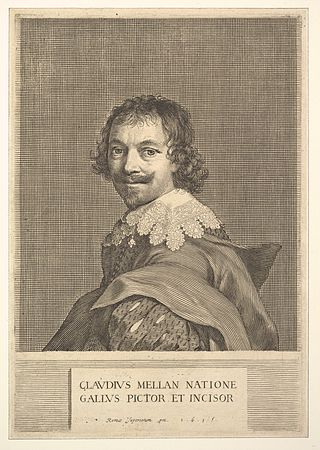
Claude Mellan was a French draughtsman, engraver, and painter.
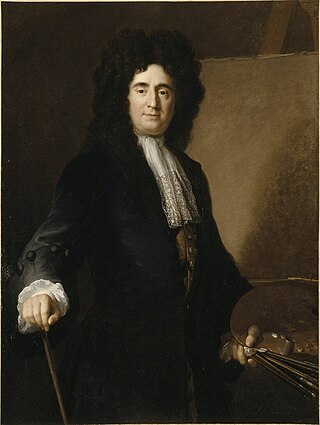
François de Troy was a French painter and engraver who became principal painter to King James II in exile at Saint-Germain-en-Laye and Director of the Académie Royale de peinture et de sculpture.

The Church of the Val-de-Grâce is a Roman Catholic church in the 5th arrondissement of Paris. The church was built as part of a royal abbey by Anne of Austria, the Queen of France, to celebrate the birth of her son, Louis XIV in 1638. Construction began in 1645 under the direction of architect François Mansart and was completed in 1665 by Gabriel Le Duc. The abbey and church were turned into a hospital during the French Revolution and then became part of the Val-de-Grâce Hospital, which closed in 1979. The church is attached to the diocese of the French military and is open to visitors at specified hours. Its dome is a landmark in the skyline of Paris.

Charles Audran (1594–1674) was a French engraver.

Étienne Baudet, an eminent French engraver, was born at Vineuil, in the department of Loir-et-Cher, about 1636. He was a pupil of Sébastien Bourdon and Cornelis Bloemaert, and afterwards went to Rome, and appears to have adopted the manner of Cornelis Bloemaert in his earliest plates, which are executed entirely with the graver. He afterwards on his return to Paris altered his manner, and calling in the assistance of the point, he executed his best prints, which bear a strong resemblance to the manner of Jean Baptiste Poilly. He made an excellent choice in the subjects of his plates, which are from the works of some of the most distinguished masters of Italy and France. He was a member of the Royal Academy of Paris, in which city he died in 1711.

Schelte a Bolswert or Schelte Adamsz. Bolswert was a Frisian engraver who worked most of his career in Antwerp where he was one of the lead engravers in Rubens' workshop. He is known for his reproductive works after Rubens and Anthony van Dyck.
Jean-François Cars, was a French engraver, printer, publisher and printseller from Lyon.
Cornelis van Caukercken was a Flemish engraver and printseller.

Guillaume Chasteau (1635–1683) was a French engraver.

Pierre Daret de Cazeneuve, a French portrait painter and engraver, was born in Paris in 1604. After receiving some instruction in engraving, he went to Rome to improve his skill, and spent a considerable time there. He was received into the Academy of Painting in 1663.
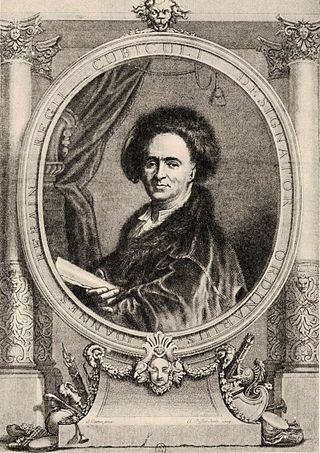
Claude Duflos (1665–1727) was a French engraver.

Paulus Pontius was a Flemish engraver and painter. He was one of the leading engravers connected with the workshop of Peter Paul Rubens. After Rubens' death, Pontus worked with other leading Antwerp painters such as Anthony van Dyck and Jacob Jordaens.

François Poilly, or François de Poilly, was a French engraver.

Jan van Haelbeck or Jan van Haelbeeck was a Flemish engraver. He was mainly active in Paris in the first 30 years of the 17th century and helped introduce copper engraving as a technique in French printing. He worked on various publication projects on religious and worldly subjects and portraits.

Philippe Thomassin was a French engraver and publisher who emigrated to Rome. He was born in Troyes on 28 January 1562 and died on 12 May 1622 in Rome.

Adoration of the Shepherds is the title of a lost drawing by Raphael, described in a letter of 8 September 1508, from Raphael to his friend Francesco Raibolini alias Francesco Francia. This letter's contents were first published in 1678, in Carlo Cesare Malvasia's book Felsina Pittrice. Malvasia gave a full account of the letter, which he claimed to have found among the papers of Count Antonio Lambertini in Bologna. While the existence and contents of the letter are disputed, according to Malvasia it described the delivery of a drawing of the Adoration of the Shepherds to Francesco Francia. This drawing has been considered lost or never to have existed.

Christophe Guérin (1758–1831) was a French engraver and painter. He is notable for his engravings and his reproductions of paintings by Raphael and Correggio.

The Calvet Museum is the main museum in Avignon. Since the 1980s the collection has been split between two buildings, with the fine arts housed in an 18th-century hôtel particulier and a separate Lapidary Museum in the former chapel of the city's Jesuit college on rue de la République. It is one of the museums run by the Fondation Calvet.
Nicolas de Poilly, also called Nicolas de Poilly the Younger, Nicolas de Poilly jeune, or Nicolas II de Poilly, was an academically trained French artist who won the Prix de Rome for painting in 1698. Despite an impressive start, he largely abandoned painting for drawing and became an engraver like his father, his uncle François de Poilly, and several others in the Poilly family.
